Bosch 1295DP, 1295DH, 1295DVS User Manual
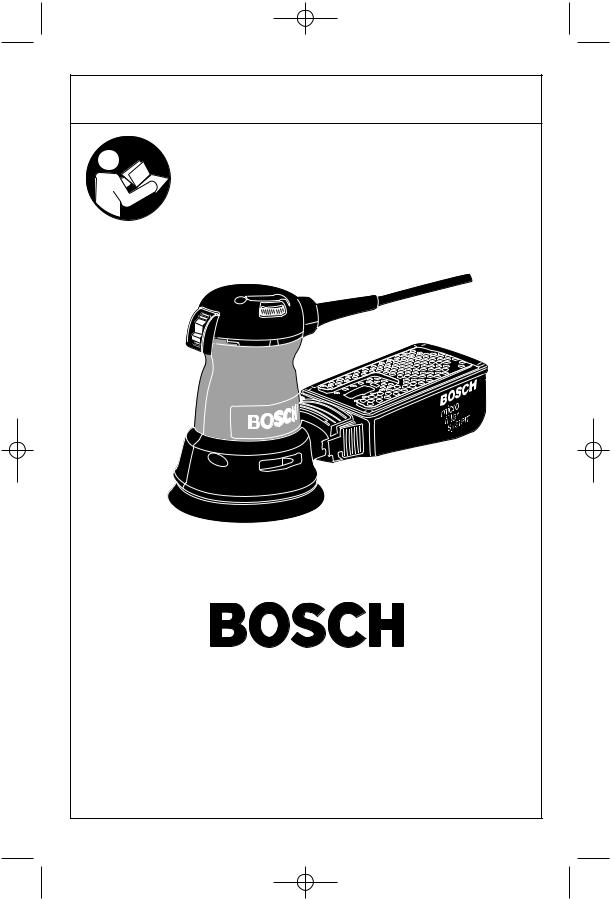
BM 2610914126 9-03 10/1/03 10:31 AM Page 1
IMPORTANT: |
IMPORTANT : |
IMPORTANTE: |
Read Before Using |
Lire avant usage |
Leer antes de usar |
Operating/Safety Instructions
Consignes de fonctionnement/sécurité
Instrucciones de funcionamiento y seguridad
6
1295D
1295DP
1295DH
1295DVS
Consumer Information
Renseignement des consommateurs
Información para el consumidor
Toll Free Number: |
Appel gratuit : |
Número de teléfono gratuito: |
1-877-BOSCH99 (1-877-267-2499) http://www.boschtools.com |
||
|
|
|
For English |
Parlez-vous français? |
¿Habla español? |
See page 2 |
Voir page 11 |
Ver página 20 |

BM 2610914126 9-03 10/1/03 10:31 AM Page 2
Power Tool Safety Rules
! WARNING Read and understand all instructions. Failure to follow all instructions listed below, may result in electric shock, fire and/or serious personal injury.
SAVE THESE INSTRUCTIONS
Work Area
Keep your work area clean and well lit.
Cluttered benches and dark areas invite accidents.
Do not operate power tools in explosive atmospheres, such as in the presence of flammable liquids, gases, or dust. Power tools create sparks which may ignite the dust or fumes.
Keep by-standers, children, and visitors away while operating a power tool.
Distractions can cause you to lose control.
Electrical Safety
Double Insulated tools are equipped with a polarized plug (one blade is wider than the other.) This plug will fit in a polarized outlet only one way. If the plug does not fit fully in the outlet, reverse the plug. If it still does not fit, contact a qualified electrician to install a polarized outlet. Do not change the plug in any way. Double Insulation 


 eliminates the need for the three wire grounded power cord and grounded power supply system. Before plugging in the tool, be certain the outlet voltage supplied is within the voltage marked on the nameplate. Do not use “AC only” rated tools with a DC power supply.
eliminates the need for the three wire grounded power cord and grounded power supply system. Before plugging in the tool, be certain the outlet voltage supplied is within the voltage marked on the nameplate. Do not use “AC only” rated tools with a DC power supply.
Avoid body contact with grounded surfaces such as pipes, radiators, ranges and refrigerators. There is an increased risk of electric shock if your body is grounded. If operating the power tool in damp locations is unavoidable, a Ground Fault Circuit Interrupter must be used to supply the power to your tool. Electrician’s rubber gloves and footwear will further enhance your personal safety.
Don't expose power tools to rain or wet conditions. Water entering a power tool will increase the risk of electric shock.
Do not abuse the cord. Never use the cord to carry the tools or pull the plug from an outlet. Keep cord away from heat, oil, sharp edges or moving parts. Replace damaged cords immediately.
Damaged cords increase the risk of electric shock.
When operating a power tool outside, use an outdoor extension cord marked "W-A" or "W." These cords are rated for outdoor use and reduce the risk of electric shock. Refer to “Recommended sizes of Extension Cords” in the Accessory section of this manual.
Personal Safety
Stay alert, watch what you are doing and use common sense when operating a power tool. Do not use tool while tired or under the influence of drugs, alcohol, or medication. A moment of inattention while operating power tools may result in serious personal injury.
Dress properly. Do not wear loose clothing or jewelry. Contain long hair. Keep your hair, clothing, and gloves away from moving parts. Loose clothes, jewelry, or long hair can be caught in moving parts. Keep handles dry, clean and free from oil and grease.
Avoid accidental starting. Be sure switch is “OFF” before plugging in. Carrying tools with your finger on the switch or plugging in tools that have the switch “ON” invites accidents.
Remove adjusting keys or wrenches before turning the tool “ON”. A wrench or a key that is left attached to a rotating part of the tool may result in personal injury.
Do not overreach. Keep proper footing and balance at all times. Proper footing and balance enables better control of the tool in unexpected situations.
Use safety equipment. Always wear eye protection. Dust mask, non-skid safety shoes, hard hat, or hearing protection must be used for appropriate conditions.
Tool Use and Care
Use clamps or other practical way to secure and support the workpiece to a stable platform. Holding the work by hand
-2-

BM 2610914126 9-03 10/1/03 10:31 AM Page 3
or against your body is unstable and may lead to loss of control.
Do not force tool. Use the correct tool for your application. The correct tool will do the job better and safer at the rate for which it is designed.
Do not use tool if switch does not turn it “ON” or “OFF”. Any tool that cannot be controlled with the switch is dangerous and must be repaired.
Disconnect the plug from the power source before making any adjustments, changing accessories, or storing the tool.
Such preventive safety measures reduce the risk of starting the tool accidentally.Store idle tools out of reach of children and other untrained persons. Tools are dangerous in the hands of untrained users.
Maintain tools with care. Keep cutting tools sharp and clean. Properly maintained tools, with sharp cutting edges are less likely to bind and are easier to control. Any alteration or modification is a misuse and may result in a dangerous condition.
Check for misalignment or binding of moving parts, breakage of parts, and any other condition that may affect the tools
operation. If damaged, have the tool serviced before using. Many accidents are caused by poorly maintained tools. Develop a periodic maintenance schedule for your tool.
Use only accessories that are recommended by the manufacturer for your model. Accessories that may be suitable for one tool, may become hazardous when used on another tool.
Service
Tool service must be performed only by qualified repair personnel. Service or maintenance performed by unqualified personnel could result in a risk of injury. For example: internal wires may be misplaced or pinched, safety guard return springs may be improperly mounted.
When servicing a tool, use only identical replacement parts. Follow instructions in the Maintenance section of this manual.
Use of unauthorized parts or failure to follow Maintenance Instructions may create a risk of electric shock or injury. Certain cleaning agents such as gasoline, carbon tetrachloride, ammonia, etc. may damage plastic parts.
Safety Rules for Orbital Sanders
Hold tool by insulated gripping surfaces when performing an operation where the cutting tool may contact hidden wiring or its own cord. Contact with a “live” wire will make exposed metal parts of the tool “live” and shock the operator.
Unplug the sander before changing accessories. Accidental start-ups may occur if sander is plugged in while changing an accessory.
If your tool is equipped with a dust bag, empty it frequently and after completion of sanding. Be extremely careful of dust disposal, materials in fine particle form may be explosive. Do not throw sanding dust on an open fire. Spontaneous combustion, may in time, result from mixture of oil or water with dust particles.
Always wear eye protection and a dust mask for dusty applications and when
sanding overhead. Sanding particles can be absorbed by your eyes and inhaled easily and may cause health complications.
Do not wet sand with this sander. Liquids entering the motor housing are an electrical shock hazard.
Do not use PSA pad on random orbit sanders whose speed exceeds 12,000/min. Exceeding the maximum operating speed of pad may cause pad to rupture or fly apart during use, striking user or bystanders.
Do not use sandpaper intended for larger sanding pads. Larger sandpaper will extend beyond the sanding pad causing snagging, tearing of the paper or kick-back. Extra paper extending beyond the sanding pad can also cause serious lacerations.
Be aware of the location and setting of the Switch “Lock-ON” Button. If the switch
-3-
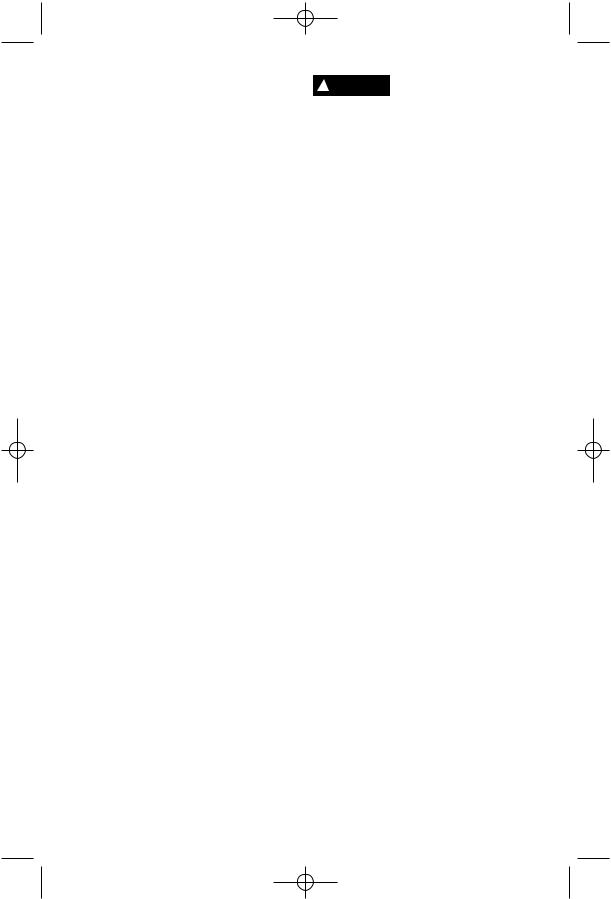
BM 2610914126 9-03 10/1/03 10:31 AM Page 4
is locked “ON”, be ready for emergency situations to switch it “OFF”, by first pulling the trigger then immediately releasing it without pressing the "Lock-ON" button.
Clamp or secure workpiece when sanding. Clamping the workpiece prevents it from being ejected from under the sander and leaves both hands to control the tool.
Keep the cord away from the spinning pad and sandpaper. The cord can become entangled with the pad.
-4-
Some dust created by power sanding, sawing, grinding, drilling, and other construction
activities contains chemicals known to cause cancer, birth defects or other reproductive harm. Some examples of these chemicals are:
•Lead from lead-based paints,
•Crystalline silica from bricks and cement and other masonry products, and
•Arsenic and chromium from chemicallytreated lumber.
Your risk from these exposures varies, depending on how often you do this type of work. To reduce your exposure to these chemicals: work in a well ventilated area, and work with approved safety equipment, such as those dust masks that are specially designed to filter out microscopic particles.

BM 2610914126 9-03 10/1/03 10:31 AM Page 5
Symbols
IMPORTANT: Some of the following symbols may be used on your tool. Please study them and learn their meaning. Proper interpretation of these symbols will allow you to operate the tool better and safer.
Symbol |
Name |
Designation/Explanation |
||||||||
|
|
|
|
|
|
|
|
|
|
|
|
|
|
|
V |
Volts |
Voltage (potential) |
||||
|
|
|
|
A |
Amperes |
Current |
||||
|
|
|
|
|
|
|
|
|
|
|
|
|
Hz |
Hertz |
Frequency (cycles per second) |
||||||
|
|
|
W |
Watt |
Power |
|||||
|
|
kg |
Kilograms |
Weight |
||||||
|
|
|
|
|
|
|
|
|
|
|
|
min |
Minutes |
Time |
|||||||
|
|
|
|
s |
Seconds |
Time |
||||
|
|
|
|
|
|
|
|
|
|
|
|
|
|
|
|
|
|
|
|
Diameter |
Size of drill bits, grinding wheels, etc. |
|
|
|
|
|
|
|
|
|
|
|
|
|
|
n0 |
No load speed |
Rotational speed, at no load |
|||||
.../min |
Revolutions or reciprocation per minute |
Revolutions, strokes, surface speed, |
||||||||
|
|
|
|
|
|
|
|
|
|
orbits etc. per minute |
0 |
|
|
|
Off position |
Zero speed, zero torque... |
|||||
|
|
|
|
|
|
|
|
|
|
|
1, 2, 3, ... |
Selector settings |
Speed, torque or position settings. |
||||||||
I, II, III, |
|
Higher number means greater speed |
||||||||
|
|
|
|
|
|
|
|
|
|
|
0 |
|
|
|
|
|
|
Infinitely variable selector with off |
Speed is increasing from 0 setting |
||
|
|
|
|
|
|
|
|
|
Arrow |
Action in the direction of arrow |
|
|
|
|
|
|
|
|
|
||
|
|
|
|
|
|
|
|
|
Alternating current |
Type or a characteristic of current |
|
|
|
|
|
|
|
|
|
|
|
|
|
|
|
|
|
|
|
|
Direct current |
Type or a characteristic of current |
|
|
|
|
|
|
|
|
|
||
|
|
|
|
|
|
|
|
|
Alternating or direct current |
Type or a characteristic of current |
|
|
|
|
|
|
|
|
|
||
|
|
|
|
|
|
|
|
|
|
|
|
|
|
|
|
|
|
|
|
Class II construction |
Designates Double Insulated |
|
|
|
|
|
|
|
|
|
||
|
|
|
|
|
|
|
|
|
|
Construction tools. |
|
|
|
|
|
|
|
|
|
|
|
|
|
|
|
|
|
|
|
|
|
|
|
|
|
|
|
|
|
|
|
Earthing terminal |
Grounding terminal |
|
|
|
|
|
|
|
|
|
||
|
|
|
|
|
|
|
|
|
Warning symbol |
Alerts user to warning messages |
|
|
|
|
|
|
|
|
|
||
|
|
|
|
|
|
|
|
|
||
|
|
|
|
|
|
|
|
|
Ni-Cad RBRC seal |
Designates Ni-Cad battery recycling |
|
|
|
|
|
|
|
|
|
|
program |
|
|
|
|
|
|
|
|
|
|
|
This symbol designates that this tool is listed by Underwriters Laboratories.
This symbol designates that this tool is listed by the Canadian Standards Association.
This symbol designates that this tool is listed to Canadian Standards by Underwriters Laboratories.
This symbol designates that this tool is listed by Underwriters Laboratories, and listed to Canadian Standards by Underwriters Laboratories.
This symbol designates that
this tool complies to NOM Mexican Standards.
-5-
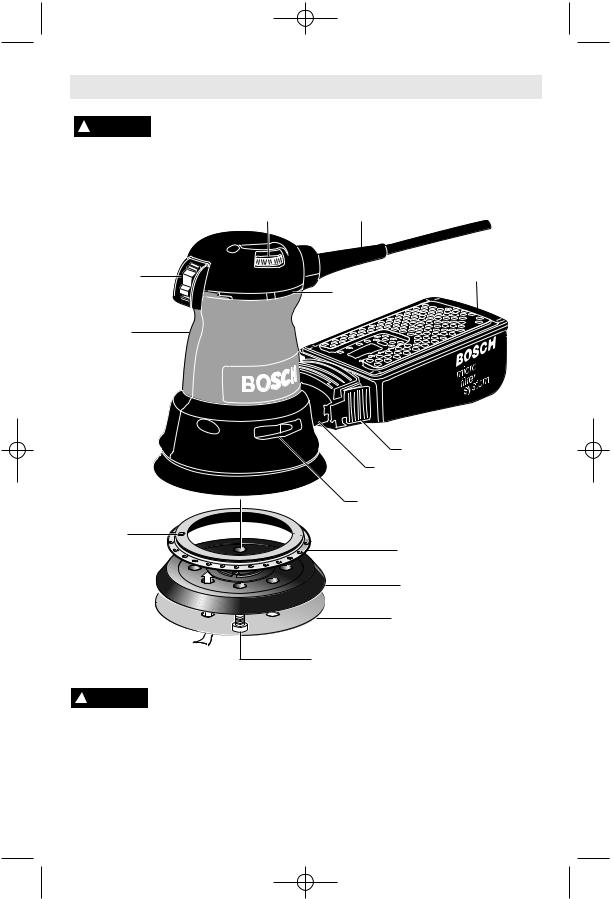
BM 2610914126 9-03 10/1/03 10:31 AM Page 6
Functional Description and Specifications
Disconnect the plug from the power source before making any assembly, adjustments or changing accessories. Such preventive
safety measures reduce the risk of starting the tool accidentally.
Random Orbit Sander
VARIABLE SPEED DIAL |
CORD |
(Model 1295DVS only) |
|
6 |
DUST |
|
|
SWITCH |
CANISTER |
|
VENTILATION |
|
OPENINGS |
RELEASE TABS
ADAPTER
VENTILATION OPENINGS
 LOCATING BUMP
LOCATING BUMP
DAMPER RING
BACKING PAD
ABRASIVE DISC
SCREW
To prevent possible swirl marks. Do not start the tool on the workpiece. Always run the tool for at least one minute before operation. This allows the
tool to reach full speed.
MAXIMUM CAPACITIES
Pad diameter 5" (125mm)
Abrasive diameter 5" (125mm)
NOTE: For tool specifications refer to the nameplate on your tool.
ALL BACKING PADS ARE INTERCHANGEABLE
-6-

BM 2610914126 9-03 10/1/03 10:31 AM Page 7
Operating Instructions
ROCKER “ON/OFF” SWITCH (Models 1295D, 1295DP, & 1295DVS)
TO TURN THE TOOL "ON" depress the upper portion of the dust-protected switch to the number “1” position.
TO TURN THE TOOL "OFF": depress the lower portion of the switch to the number “0” position.
THREE-POSITION ROCKER SWITCH WITH
SWIFTSAND™ SETTING
(Model 1295DH only)
Your tool is equipped with a three-position switch which allows normal surface finishing or faster stock removal with the SwiftSand™ option.
TO TURN THE TOOL "ON" for normal finishing, depress the lower portion of the dust-protected switch to the number (1) position.
TO THE TURN THE TOOL "ON" in the SwiftSand™ (high removal) setting, depress the upper portion of the switch to the number
(2) position.
TO TURN THE TOOL "OFF" from either setting move the switch to the center number “0” position.
Setting Applications
1Normal surface finishing for wood, plastics, solid-surfacing and composites.
2SwiftSand™ setting for solid wood, fast stock removal, paint removal, fast blending of joints or repairs in solid surfacing.
Metal sanding and finishing, chipboard, course sanding of wood and other surfaces.
Finish removal, light polishing or scratch blending.
VARIABLE SPEED WITH DIAL SETTING (Model 1295DVS only)
Your sander is also equipped with a variable speed dial. The sander's orbital pad speed can be preset from minimum to maximum nameplate OPM by rotating the dial in the housing. The dial may be set on or between any of six positions (1=low through 6=high).
The following table may be used as a general guide for abrasive and backing pad selection, but the best results will be obtained by sanding a test sample of the workpiece first.
|
Switch |
Backing |
Grit |
|
Material |
setting |
pad |
size |
|
woods: |
rough/finish |
|
rough/finish |
|
|
|
|
|
|
softwoods |
4 / 6 |
soft |
60 |
/ 240 |
hardwoods |
4 / 6 |
med |
60 |
/ 180 |
veneers |
4 |
soft |
240 |
/ 320 |
metals: |
|
|
|
|
steel |
4 |
med |
60 |
/ 240 |
stainless |
4 |
med |
120 |
/ 240 |
aluminum |
4/ 6 |
med |
80 |
/ 240 |
rust spots |
6 |
soft |
60 |
/ 120 |
paintwork: |
|
|
|
|
sanding |
2 / 3 |
med |
180 |
/ 400 |
scratches |
4 / 6 |
hard |
120 |
/ 240 |
stripping |
4 |
med |
40/60 /80 |
|
BACKING PAD INSTALLATION
The random orbit sander is equipped with a backing pad of medium hardness, which is suitable for general service. Harder and softer pads are available for other purposes, and in general are used as follows;
Soft pad - Polishing or sanding large or curved surfaces.
Medium pad - All purpose general sanding and polishing.
Hard pad - Heavy sanding on flat surfaces, especially with coarser abrasives.
To change backing pad, hold pad firmly and turn screw counterclockwise with 5mm allen wrench provided. Remove old pad, and place new pad over locating pins on drive spindle. Replace screw and securely tighten in a clockwise direction with the allen wrench. Damaged or worn backing pads must be replaced immediately.
BACKING PAD DAMPER
Your tool is equipped with an integrated backing pad damper ring. This damper reduces the no-load speed, which helps prevent accidental marking of the workpiece surface and provides uniform finishing.
-7-

BM 2610914126 9-03 10/1/03 10:31 AM Page 8
NOTE: If you notice steadily increasing noload speed, this indicates that the damper ring is worn and needs to be replaced.
To replace damper ring, remove backing pad as described in “Backing Pad Installation” and remove worn damper ring by pulling firmly out of locating groove. Loosen the two screws on shroud just enough so you can separate shroud approximately 1/4 inch. Align locating bumps on damper ring with cut outs in shroud and depress ring with thumbs until shroud seats into groove completely around ring, then tighten screws.
IMPORTANT: Ring should not have bends or ripples when correctly seated.
Apply a thin film of light grease to top side of backing pad where the damper ring makes contact, reassemble backing pad and firmly tighten screw.
DAMPER RING
SHROUD
BACKING
PAD
 LOCATING
LOCATING
BUMPS ON
UNDERSIDE
OF DAMPER
RING
INSTALLING ACCESSORIES
(Model 1295D 1295DH & 1295DVS)
Your random orbit sander uses hook-and-loop backed accessories, which firmly grip the pad when applied with moderate pressure. To change the accessory, merely peel off the old accessory, remove dust from the pad if necessary, and press the new accessory in place. Be sure to align the sanding disc holes with the holes in the backing pad to allow the dust extraction system to function.
After considerable service the pad surface will become worn, and the pad must be replaced when it no longer offers a firm grip. If you are experiencing premature wearout of the pad facing, decrease the amount of pressure you are applying during operation of the tool.
(Model 1295DP only)
Your sander is equipped with PSA backed accessories with pressure sensitive adhesive. To change accessory, peel protective sheet from the back of accessory. Align accessory with backing pad and press firmly in place. To remove, lift an edge of accessory with your finger nail and peel it off the backing pad.
NOTE: Do not store tool with sanding disc on pad, as sanding creates heat which increases the adhesive bond. If the disc is left in place it may become very difficult to remove.
DUST COLLECTION CANISTER
The integral dust extraction system collects sanding dust in canister supplied with your sander. For maximum efficiency, the dust canister should be emptied frequently during operation.
When the canister is removed from the tool an (optional vacuum hose accessory) can be attached to the dust port.
To use this feature, attach vacuum adapter and vacuum hose (optional accessories) to dust port, then connect opposite end of the vacuum hose to a shop vacuum cleaner.
CLEANING AND EMPTYING
THE DUST CANISTER
To empty, lift lid of canister. Knock excess dust out of the micro filter, or remove dust with your fingers or a soft brush.
You may notice that all the dust may not come out of the canister. This will not affect sanding performance but will reduce dust collection efficiency.
NOTE: Do not wash the micro filter with soap and water. Dust may become more firmly lodged in the pores, which will reduce dust collection, and damage the micro filter.
-8-
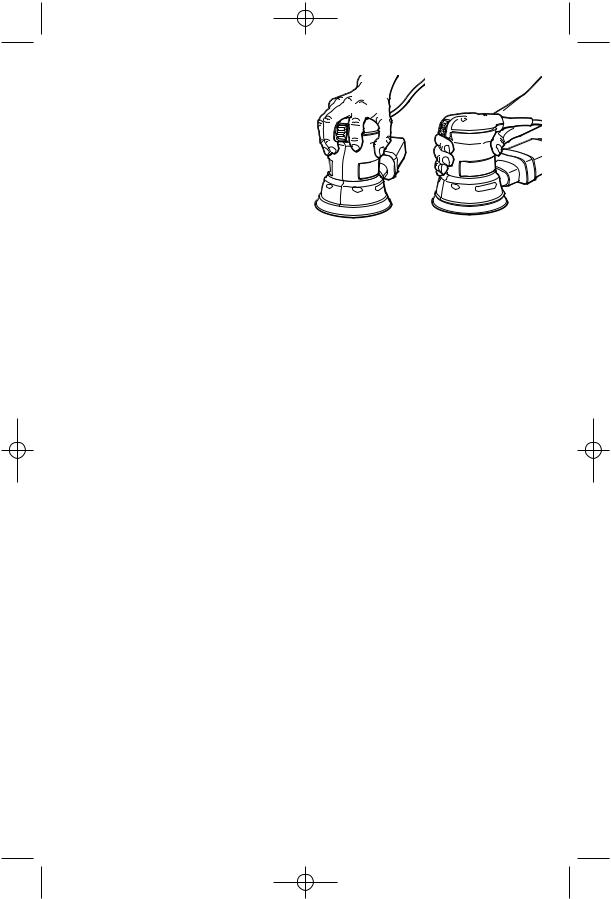
BM 2610914126 9-03 10/1/03 10:31 AM Page 9
Your sander was designed to sand in small or confined areas. Its small size and light weight makes it ideal for overhead work.
You may grip the tool on top or around the motor housing as shown, which was contoured for that purpose.
“Tool Tips”
SANDING: open-coat aluminum oxide sanding discs are recommended for most wood or metal sanding applications, as this synthetic material cuts quickly and wears well. Some applications, such as plastics, glass, or stone require silicon carbide discs, which have a very sharp cutting edge. For best results, use Bosch sanding and polishing accessories which are of superior quality and are carefully selected to produce professional quality results with your sander.
With the workpiece firmly secured, depress switch while applying the pad to the work surface. DO NOT apply excessive pressure as this will slow the pad action, and DO NOT start the tool and bring it up to speed before applying to the work; swirl marks will result in either case. In general, higher speeds and moderate pressure will give the best results. If faster removal is desired, DO NOT INCREASE PRESSURE ON THE TOOL; use a coarser grade of abrasive. Move the sander in long sweeping strokes, parallel to the grain using some lateral motion to overlap the strokes by as much as 75%. The random orbit action allows cross-grain sanding, but be careful not to tilt the sander near edges, or undesirable rounding may result.
If the surface is rough, begin with coarser grits and then complete the surfacing with medium and fine abrasives. Because the random orbit action is so effective, it is often possible to begin sanding with a medium grit disc and go directly to fine finishing. To avoid uneven results, do not skip more than one grit size when going from coarser to finer, and do not sand in one area for too long. When the job is completed, release switch, and gently lift the tool from the work surface at the same time.
POLISHING: for most polishing, the soft backing pad will give the best results. The random orbit sander may be fitted with a foam buffing pad or polishing bonnet to polish or remove scratches from painted or finished surfaces, plastics, and even glass. The tool is operated in much the same way as when sanding, but the following points should be observed;
Apply the compound to the surface, and use the sponge applicator pad with light pressure and a circular motion to remove scratches and restore weathered finishes. Use only as much compound as necessary, and clean the sponge frequently during use.
When initial polishing is completed, wipe away any excess compound with a soft towel, and then polish the surface to its final finish with the polishing bonnet. Use smooth overlapping strokes for best results.
It is important to note that the orbit speed of the random orbit sander is not the same as the RPM of a standard right-angle polisher. The random orbit action is much like a powerful hand polishing action, and therefore does not have the high speeds at the edge of the pad which can burn the work surface. For this reason, it is possible to select a higher OPM for the random orbit sander than the recommended RPM for a standard polisher. Practice on a hidden area or test surface until you have determined the tool is suitable for your polishing application.
Clean the buffing pad and polishing bonnet with mild detergents and warm water. DO NOT use solvents.
-9-
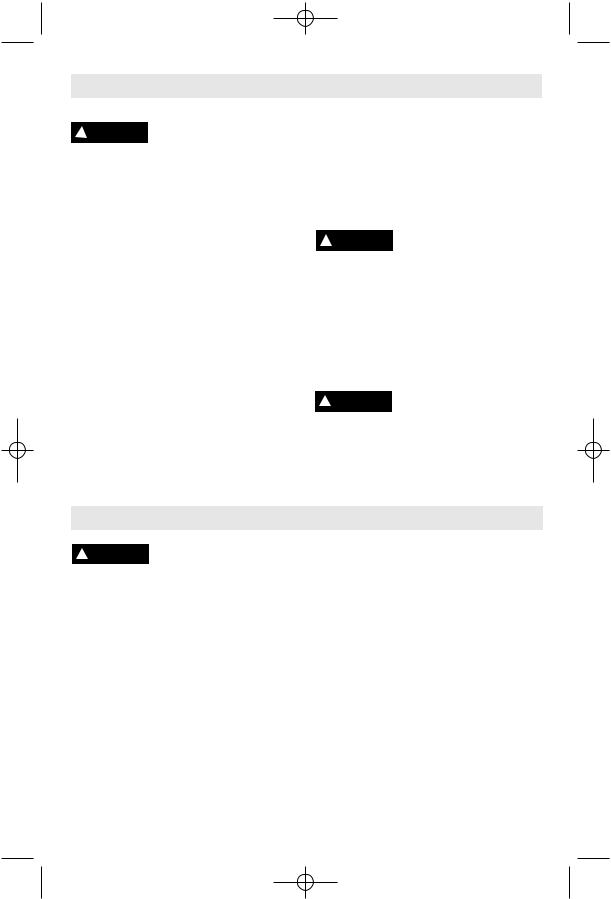
BM 2610914126 9-03 10/1/03 10:31 AM Page 10
Maintenance
Service
Preventive maintenance performed by unauthorized personnel may result in misplacing of
internal wires and components which could cause serious hazard. We recommend that all tool service be performed by a Bosch Factory Service Center or Authorized Bosch Service Station.
TOOL LUBRICATION
Your Bosch tool has been properly lubricated and is ready to use. It is recommended that tools with gears be regreased with a special gear lubricant at every brush change.
CARBON BRUSHES
The brushes and commutator in your tool have been engineered for many hours of dependable service. To maintain peak efficiency of the motor, we recommend every two to six months the brushes be examined. Only genuine Bosch replacement brushes specially designed for your tool should be used.
BEARINGS
After about 300-400 hours of operation, or at every second brush change, the bearings
should be replaced at Bosch Factory Service Center or Authorized Bosch Service Station. Bearings which become noisy (due to heavy load or very abrasive material cutting) should be replaced at once to avoid overheating or motor failure.
Cleaning
To avoid accidents, always disconnect the tool from the power supply before
cleaning or performing any maintenance.
The tool may be cleaned most effectively with compressed dry air. Always wear safety goggles when cleaning tools with compressed air.
Ventilation openings and switch levers must be kept clean and free of foreign matter. Do not attempt to clean by inserting pointed objects through openings.
Certain cleaning agents and solvents damage plastic parts. Some of these are: gasoline,
carbon tetrachloride, chlorinated cleaning solvents, ammonia and household detergents that contain ammonia.
Accessories
If an extension cord is ! WARNING necessary, a cord with
adequate size conductors that is capable of carrying the current necessary for your tool must be used. This will prevent excessive voltage drop, loss of power or overheating. Grounded tools must use 3-wire extension cords that have 3-prong plugs and receptacles.
NOTE: The smaller the gauge number, the heavier the cord.
RECOMMENDED SIZES OF EXTENSION CORDS 120 VOLT ALTERNATING CURRENT TOOLS
Tool’s |
Cord Size in A.W.G. |
Wire Sizes in mm2 |
|||||||
|
|
|
|
|
|
|
|
||
Ampere |
|
|
|
|
|
|
|
|
|
Cord Length in Feet |
Cord Length in Meters |
||||||||
Rating |
|||||||||
25 |
50 |
100 |
150 |
15 |
30 |
60 |
120 |
||
|
|||||||||
3-6 |
|
|
|
|
|
|
|
|
|
18 |
16 |
16 |
14 |
0.75 |
0.75 |
1.5 |
2.5 |
||
6-8 |
18 |
16 |
14 |
12 |
0.75 |
1.0 |
2.5 |
4.0 |
|
8-10 |
18 |
16 |
14 |
12 |
0.75 |
1.0 |
2.5 |
4.0 |
|
10-12 |
16 |
16 |
14 |
12 |
1.0 |
2.5 |
4.0 |
— |
|
12-16 |
14 |
12 |
— |
— |
— |
— |
— |
— |
|
|
|
|
|
|
|
|
|
|
|
-10-
